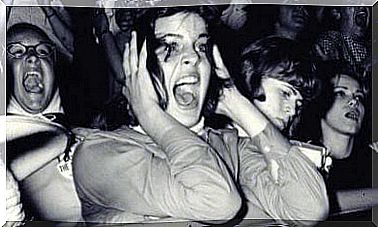Do You Have An Anxiety Or A Panic Attack?

The terms anxiety and panic attack are often used synonymously. But they are not the same. In fact, some important characteristics distinguish them even though they have certain symptoms in common. This is something that can really seem confusing at first. In fact, even professional psychologists often use the two terms incorrectly.
Not knowing the difference, however, can make it difficult to find the right treatment or to develop useful management tools. As you can understand, these differences are more than just a matter of semantics.
One can deal with the patient’s fall and the problems behind the attacks more effectively by understanding the symptoms of an anxiety or a panic attack. The basic discomfort differs between the conditions, and the same applies to how they develop. Therefore, it is important to be able to distinguish between them.

Is it an anxiety attack or a panic attack?
An anxiety attack often occurs as a reaction to a stressful situation or a particular concern. For example, you may have been afraid of being fired for a while, and when your boss calls you and wants a meeting in the office, your anxiety symptoms skyrocket.
You can feel scared and anxious when you suffer from an anxiety attack. The heart can beat very fast and you can feel short of breath. But all this is transient, and disappears at the same time as the stressing factor.
A panic attack, on the other hand, occurs even though there is no real danger or obvious cause for it. There is no real trigger, so in some cases it can be very unpredictable. A person who goes through a panic attack usually experiences strong feelings of fear, anxiety or worry.
It can feel like you are dying, losing control or having a heart attack. In fact, one can experience a variety of physical symptoms that can include chest pain, shortness of breath, dizziness and nausea.
Are these designations included in the DSM?
“Anxiety attack” is not included in any diagnostic category in the latest edition of the Diagnostic and Statistical Manual of Mental Disorders ( DSM-5 ).
- Anxiety attack is in fact a non-clinical term that we use in everyday speech for people who experience anxiety, and which describes episodes of intense or prolonged anxiety.
- Panic attacks are easy to define because here is a clinical description. The official DSM definition is: ” A panic attack is a sudden episode of intense fear that triggers severe physical reactions without any real danger or obvious cause. “
Symptoms of an anxiety attack
In this case, the anxiety reaches a peak that can last for a long time; either until the trigger disappears, you manage to use an alternative management strategy, or the attack completely empties your physiological system.
It is a more serious condition than just a single feeling of anxiety, but it usually does not reach the same levels of activity that are triggered by an actual panic attack. An anxiety attack can last for minutes, hours, days or weeks. It usually manifests itself with one or more of the following symptoms:
- Restlessness or a feeling of exhaustion or nervousness.
- Intense exhaustion without any physical or mental exertion.
- Concentration difficulties.
- Irritability.
- Muscle tension.
- Difficulty controlling anxiety.
- Sleep disorders (difficulty falling asleep, staying asleep or a restless or unsatisfactory sleep).
Therapist Ginger Poag defines an anxiety attack as an episode of worry about possible future events. There are times when an anxiety attack acts as a prelude to a panic attack.
But unlike these, anxiety attacks are not a symptom of an anxiety disorder. In fact, anxiety is a natural reaction to certain stimuli or situations, and these types of “attacks” are really just more intense forms of these types of emotions.
In addition, anxiety attacks often lead to avoidance patterns or excessive caution. For example, a person who has experienced socially motivated anxiety may avoid places or situations that once created this anxiety. This can of course lead to a life situation that becomes limited and less fulfilling, both for the individual and for society.
Symptoms of a panic attack
An anxiety disorder, unlike a panic attack, cannot trigger severe physical reactions. Many of those who experience a panic attack think that they are having a heart attack. In fact, some even call the emergency number because they do not know what is happening. They usually have at least some of the following symptoms and these usually last for about 10 to 15 minutes:
- The feeling of a loved one’s death or imminent danger
- The fear of losing control or dying
- Fast and hard pounding heart.
- Sweating
- Tremors
- Shortness of breath or tightness in the throat
- Hot flashes
- Nausea
- Stomach aches
- Chest pain
- Headache
- Dizziness, vertigo or fainting
- Numbness or tingling
- Feelings of being separated from reality.
The victims often experience the feeling of an immediate threat when they experience a panic attack. Thus, they respond by asking for help or trying to escape from the situation they are experiencing. Some people only suffer from one or a few panic attacks during their lifetime.
These usually occur during periods of extreme stress or pressure. Repeated panic attacks are often a symptom of a panic disorder. Some traumatic events can be of such a nature that after a while they trigger panic syndrome in an individual.

How to distinguish between an anxiety and a panic attack
The symptoms of an anxiety and a panic attack are quite similar. Thus, it can be difficult to distinguish them. These tips can help:
- Panic attacks usually occur without triggers. Anxiety attacks are primarily a response to a perceived threat.
- The symptoms of a panic attack are intense and unpleasant. Often they also bring a feeling of being separated from reality. The symptoms of anxiety vary in intensity and range from mild to severe.
- Panic attacks occur suddenly, while the symptoms of anxiety gradually intensify over a few minutes, hours or even days.
- A panic attack lasts for a few minutes, while an anxiety attack can last for extended periods.
It is important to know the difference between an anxiety attack and a panic attack because many patients think they are experiencing one when in fact it is the other. This confusion is the reason why many do not seek medical help.
In the worst case, you can become addicted to medications you do not need if the person making the diagnosis mixes the two conditions. For this reason, it is extremely important that healthcare professionals understand the differences.









